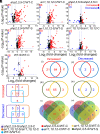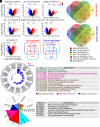Defective cytokinin signaling reprograms lipid and flavonoid gene-to-metabolite networks to mitigate high salinity in Arabidopsis
- PMID: 34815339
- PMCID: PMC8640937
- DOI: 10.1073/pnas.2105021118
Defective cytokinin signaling reprograms lipid and flavonoid gene-to-metabolite networks to mitigate high salinity in Arabidopsis
Abstract
Cytokinin (CK) in plants regulates both developmental processes and adaptation to environmental stresses. Arabidopsis histidine phosphotransfer ahp2,3,5 and type-B Arabidopsis response regulator arr1,10,12 triple mutants are almost completely defective in CK signaling, and the ahp2,3,5 mutant was reported to be salt tolerant. Here, we demonstrate that the arr1,10,12 mutant is also more tolerant to salt stress than wild-type (WT) plants. A comprehensive metabolite profiling coupled with transcriptome analysis of the ahp2,3,5 and arr1,10,12 mutants was conducted to elucidate the salt tolerance mechanisms mediated by CK signaling. Numerous primary (e.g., sugars, amino acids, and lipids) and secondary (e.g., flavonoids and sterols) metabolites accumulated in these mutants under nonsaline and saline conditions, suggesting that both prestress and poststress accumulations of stress-related metabolites contribute to improved salt tolerance in CK-signaling mutants. Specifically, the levels of sugars (e.g., trehalose and galactinol), amino acids (e.g., branched-chain amino acids and γ-aminobutyric acid), anthocyanins, sterols, and unsaturated triacylglycerols were higher in the mutant plants than in WT plants. Notably, the reprograming of flavonoid and lipid pools was highly coordinated and concomitant with the changes in transcriptional levels, indicating that these metabolic pathways are transcriptionally regulated by CK signaling. The discovery of the regulatory role of CK signaling on membrane lipid reprogramming provides a greater understanding of CK-mediated salt tolerance in plants. This knowledge will contribute to the development of salt-tolerant crops with the ability to withstand salinity as a key driver to ensure global food security in the era of climate crisis.
Keywords: comparative metabolomics; comparative transcriptomics; cytokinin signaling; regulatory network; salt stress.
Copyright © 2021 the Author(s). Published by PNAS.
Conflict of interest statement
The authors declare no competing interest.
Figures




References
-
- Munns R., Gilliham M., Salinity tolerance of crops—What is the cost? New Phytol. 208, 668–673 (2015). - PubMed
-
- Abiala M. K., Abdelrahman M., Burritt D. J., Tran L. P., Salt stress tolerance mechanisms and potential applications of legumes for sustainable reclamation of salt-degraded soils. Land Degrad. Dev. 29, 3812–3822 (2018).
Publication types
MeSH terms
Substances
LinkOut - more resources
Full Text Sources
Molecular Biology Databases
Research Materials

